
Mastering Podcast Show Notes (Examples & Templates Included)
2023-06-01
Show notes aren’t just an accessory, they're an essential element. A magnet that attracts, a guide that directs, and a teaser that entices.
If you're ready to level up your podcasting game, dive into this guide on crafting show notes that work.
Steps for Writing Great Show Notes
The main goal with show notes should be to complement your audio content. Here are some important steps to make sure your show notes hit the mark every time.
1. Write the Episode Summary
Start off by breaking down what your episode is all about.
Make it clear and snappy so that anyone who sees it knows what they're in for. But here's the key: sprinkle in a bit of curiosity to give them that "I gotta know more" feeling.
Plus, here's a tip: a well-done summary can boost your podcast's discoverability. Sneak in some keywords naturally so that your episode pops up when people search for similar stuff online.
And last but not least, keep your summary vibe in tune with your podcast's style. Whether it's chill, super-smart, or just plain fun, make sure your summary gives people a taste of the podcast experience they're signing up for.
2. Add Timestamps for Key Segments
Timestamps let your listeners skip to the best parts right away. These are especially handy for your extra-long episodes or when you've talked about a bunch of different topics.
So, here's how you do it: while editing your notes, keep an eye out for those "Aha!" moments, when a new topic pops up or the conversation takes an interesting turn. Write down the times like you're making a map for your audience.
Timestamps aren't just for convenience. They're a sneak peek into your episode's soul. A well-organized timestamp section can be a teaser reel, showing off all the awesome parts your listeners are about to get into.
Oh, and here's a ninja SEO trick: when you list all those topics with their timestamps, you're giving Google a roadmap to your content. It's not just about helping your listeners navigate, it's about making sure your episode pops up in search results.
3. List Key Takeaways or Highlights
Key takeaways are the stuff you really want your listeners to remember, the Cliff's Notes version of your podcast—short, sweet, and to the point.
When it comes to presenting the nuggets of wisdom, don't hide them in long text or paragraphs. Use bullet points or numbered lists. You want to give your readers a quick glance packed with value.
These key takeaways can also be a social media secret weapon. Sharing a teaser of these insights on your social media can get folks buzzing and drive more traffic to your episode.
4. Incorporate Relevant Links and Resources
One of the problems with links and resources is that it can be hard to know what to include. But if you think about it, you've got a smorgasbord of options to link to:
- Cool blog posts
- Must-read books
- Awesome products
- Other podcast episodes
And if you've had awesome guests, why not link to their websites or social media profiles? It's a friendly gesture that also lets your listeners explore more.
Here's the pro move: organize your links neatly. Use engaging subheadings like 'Mentioned in this Episode,' 'Resources,' or 'Further Reading.' This way, your show notes become easy to skim through and super user-friendly.
Finally, make those links top-notch, relevant, and trustworthy. Nobody wants to click on a dud.
5. Include Contact Information
Contact information is where the engagement magic happens. It's like saying, "Hey, we're here, and we want to chat with you."
In your show notes, create a corner with your social media handles and website links. If you've got a team running the show, share their contact info too.
6. Embed a Call to Action
The main point of a Call to Action (CTA) is to encourage a specific action that benefits both the listener and your podcast. It could be a prompt to subscribe, share the episode, follow you on social media, or explore a sponsor's offer.
When crafting your CTA, keep it crystal clear. Tell your audience exactly what you want them to do. Simplicity is the name of the game; too many CTAs can be overwhelming.
Last but not least, be a detective. Keep an eye on how well your CTAs are working. Are people subscribing, sharing, or diving into sponsor offers? Analyzing listener engagement helps you fine-tune your CTAs for even better results.
Podcast Show Notes Examples
Now that we've talked about some of the most important steps in putting together show notes, let's look at podcast show note templates used by two of the most popular podcasters in the world.
Andrew Huberman
Dr. Andrew Huberman is a neuroscientist and professor at Stanford University known for his groundbreaking research in the field of neuroscience, specifically on topics related to brain function, visual perception, and neural plasticity.
He hosts a popular podcast called "The Huberman Lab Podcast." It's an excellent resource for anyone interested in understanding the inner workings of the brain and how they relate to everyday life.
Here's an example of his show notes on Spotify:
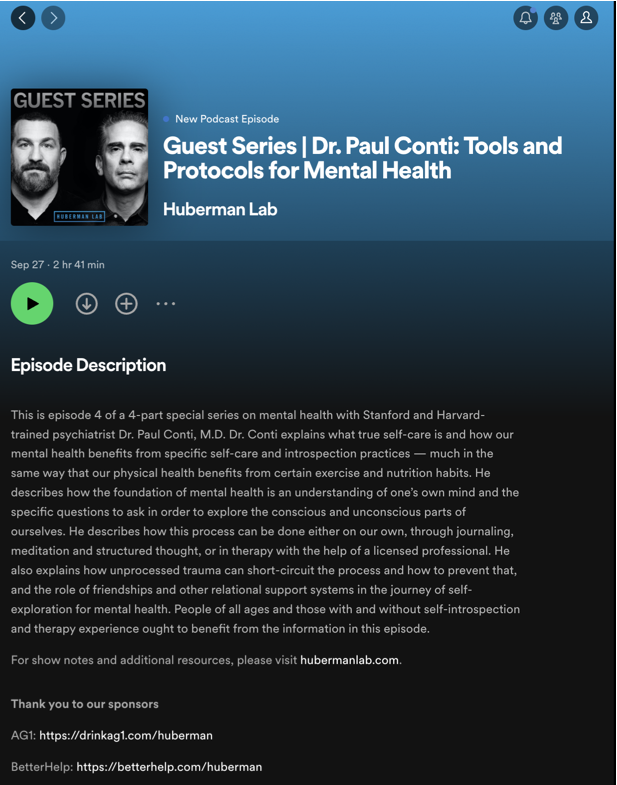
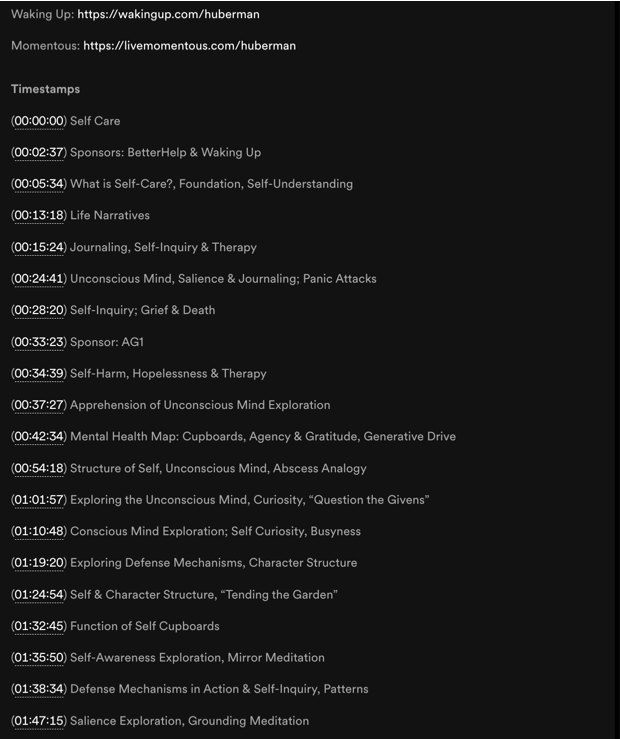
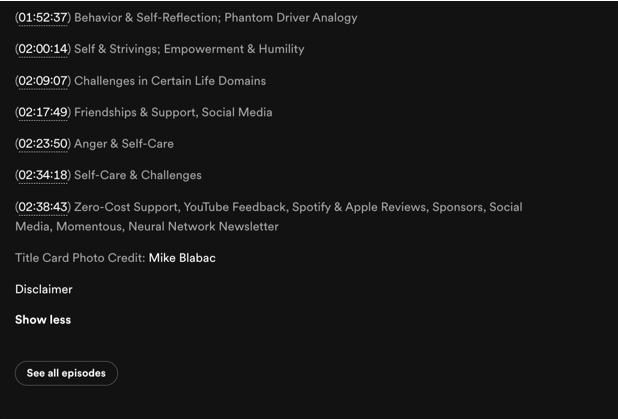
Huberman uses the description field to let the listener know what the episode is about.
He also effectively uses timestamps to let his listeners know exactly where to find relevant material they might be more interested in.
This is especially important for longer podcasts (you can see that this particular episode is over 2 hours long, so these timestamps are super important.)
Tim Ferris
Tim Ferriss is a renowned author, entrepreneur, and podcast host. He is best known for his bestselling books, including "The 4-Hour Workweek," "Tools of Titans," and "Tribe of Mentors." "The Tim Ferriss Show" is his popular podcast.
The show features in-depth interviews with a wide range of guests, including world-class performers, entrepreneurs, authors, athletes, and experts in various fields.
Here is what his show notes look like on Spotify:

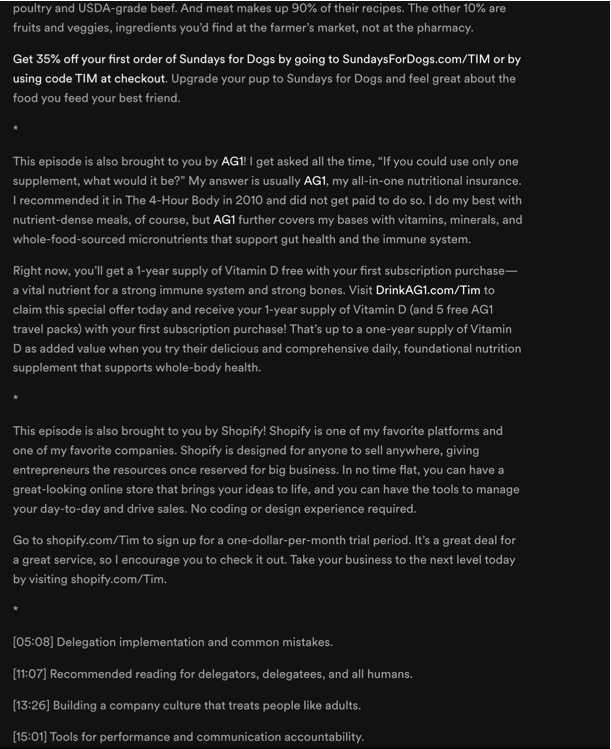
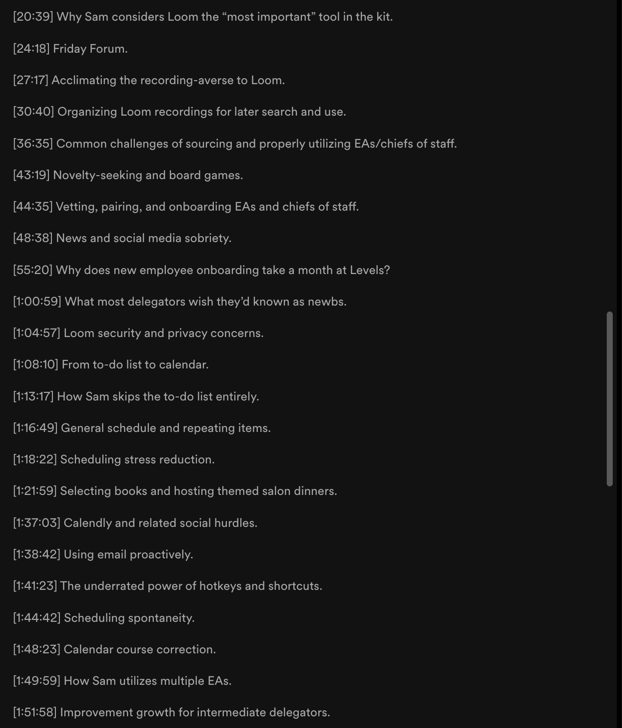
One thing you might notice right away when comparing Ferriss’ show notes to Huberman's is that Ferris doesn't include a description of the episode. Instead, he uses the first part of his show notes to shout-out his sponsors.
Then he immediately adds his timestamps. This shows that there is no right or wrong way to do your own podcast show notes.
Speaking of different styles, let's talk about some ideas you could include in your own show notes.
Podcast Show Notes Template
[Introduction - Write 2-3 sentences introducing what the episode is about. Share a brief bio of the speaker(s). If it's a well-known personality, perhaps highlight a lesser-known fact to intrigue listeners.]
[Timestamps - This segment is crucial for listeners who want to jump to specific sections of your podcast or revisit certain segments.]
[Relevant Links - Whether you're referencing a book, a study, or another podcast episode, provide direct links to these resources.]
[Call to Action - Encourage the listener to engage with your podcast actively. Ask them to subscribe, rate, or review your podcast.]
[Connect With Us - Don't let the conversation end with the podcast. Include your and/or your guest's social media handles, website, or email.]
[Sponsors - Acknowledge and provide information about the brands and organizations that have sponsored the episode.]
Advanced Podcast Show Notes Ideas
Here are some advanced podcast notes tips.
Utilize Embedded Audio Highlights
Imagine this: you had an epic guest interview, and they dropped some wisdom that gave you goosebumps. Why not embed that snippet of brilliance in your show notes?
Or maybe there was a hilarious moment that had everyone laughing. Those spontaneous laughs are like podcast gold.
Audio highlights aren't just pretty decorations; they're little teasers that make readers want to become listeners. Clicking play on your full episode becomes irresistible when they've had a taste of the good stuff.
When you're picking these audio gems, think about what affected you the most—moments that tugged at the heartstrings, dropped some serious knowledge, or made people curious to know more. Those are great audio clips to add to your notes.
Add Visual Elements like Images or Infographics
Infographics are the superhero sidekicks of complex topics.
Let's say you're diving into a podcast episode about the global economy and the episode has tons of facts and figures. It's going to be really difficult for readers to go over show notes filled with walls of data and text.
But, throw in an infographic breaking down the key points, and suddenly, it's like someone turned on the lights.
And if you've had an amazing guest, why not give your listeners a face to connect with? A high-quality image of them in your show notes adds a personal touch your listeners will appreciate.
Answer Listener Questions and Provide Responses
Having a dedicated Q&A segment in your episode is like opening the floor to your listeners, saying, "Hey, what's on your mind?"
The best part is that you can then transfer those questions and answers to your show notes. This tells your audience that their thoughts, their questions, and their engagement matter.
But don't stop there. Encourage your listeners to keep the questions coming, whether it's through social media or a form on your website.
The more questions, the better. This interactive segment might unearth topics and concerns you hadn't even thought of addressing.
Suggest Episodes for Binge-Listening
Your podcast isn't just a random collection of episodes; it's a collection of stories and knowledge to be discovered.
Imagine you could hand your audience a map to this store of knowledge—that's what creating a binge-listening list in your show notes is all about.
Let's say your podcast is all about self-improvement. Group together episodes that tackle conquering fear, turning them into a mini-series.
Or, if you're all about entrepreneurship, handpick a list of episodes featuring rockstar startup founders. These curated lists are like guided tours, taking your listeners on thematic adventures, and helping them dive deeper into the topics they love.
Automating Podcast Show Notes
For podcasters and content creators, curating these notes can be tedious.
Enter the "Show Notes Generator" app - a tool designed to streamline and automate this process using AI.
Here are some of the features:
Show Notes Automation: Whether you need a succinct summary, relevant hashtags, precise timestamps, or a full transcript of your episode, the Show Notes Generator has got you covered. It not only saves time but ensures consistency across episodes.
Speaker Identification: For podcasts with multiple speakers or guest appearances, this feature is a gem. It recognizes different speakers, making the notes clearer for listeners and highlighting key moments.
Extract Quotes and Highlights: Every podcast episode has those golden nuggets of wisdom or humor. The Show Notes Generator can identify and extract these moments, making them easy for listeners to reference or share.
SEO Optimization: Visibility is key. The app is designed not only to generate show notes but also to optimize them for search engines. By doing so, it aims to increase the visibility of your podcast, drawing more listeners to your content.
Integration with Podcast Platforms: To make the distribution seamless, the app offers easy integration with major podcast directories like Apple Podcasts, Spotify, and Google Podcasts.
Call-to-Action Generator: Engaging your listeners doesn’t stop at delivering content. With the call-to-action generator, you can direct your audience towards specific actions, be it visiting a sponsor's page, checking out supplementary materials, or joining a community.
Fine-Tuning: While automation is convenient, personalization is crucial. The app provides options to tweak the generated notes to align with your unique style or the specific intention of an episode.
Multi-Language Support: Catering to a global audience? No worries. The app supports multiple languages, ensuring your content is accessible and understood by listeners from different linguistic backgrounds.
As you journey in the world of podcasting, ensure you’re equipped with the best tools to make your content stand out.
Enhance Your Show Notes through Expert Services
Another option besides automating your podcast show notes is to hire professionals. There are lots of different platforms that you can use to hire.
Upwork
Think of Upwork as your connection to a world of freelancers. Creating a job posting here is like sending out a signal to skilled show note writers. Be super clear about your needs and budget.
That's how you attract the right talent. As proposals start rolling in, take your time to dig into their previous work and reviews. And when you find that perfect match, remember, communication is the key to making sure your show notes turn out just how you want them.
Fiver
Fiverr is a marketplace where freelancers offer their talents. There's a smorgasbord of sellers ready to whip up show notes that fit your requirements.
Dive into the gigs, check out the reviews, and don't hesitate to ping the sellers with your questions.
It's all about finding that special someone whose style meshes perfectly with your podcast's vibe.
Beyond Upwork and Fiverr
Other platforms like Freelancer and Toptal offer their own troves of talented writers. And if you're feeling adventurous, explore social media. LinkedIn or podcasting communities can also be great locations for discovering show note experts.
Cast your net wide, and you'll up your chances of finding that perfect match for your podcast show notes.
Final Thoughts
It's evident that mastering show notes can significantly amplify listener engagement and bolster growth.
When considering the avenues to generate show notes – be it in-house, automated, or outsourced – there isn't a one-size-fits-all answer. Each method comes with its set of advantages and caveats:
In-House: Crafting show notes in-house gives you maximum control. However, it can be time-consuming, demanding a significant portion of your resources.
Automated: Tools like the Show Notes Generator, simplifies the process. It promises speed and consistent output. Yet, relying solely on AI might mean occasionally missing the nuanced human touch, leading to oversights.
Outsourced: Outsourcing the task to experts can guarantee quality and free up your time. With platforms like Upwork and Fiverr, finding skilled professionals has never been easier. However, this option might dig deeper into your pockets, and there's a learning curve in aligning the outsourced talent with your brand's voice.
Ultimately, the route you choose should align with your podcast's objectives, budget, and desired listener experience.
FAQs About Podcast Show Notes
How do I measure the effectiveness or ROI of my show notes?
Measuring the effectiveness of your show notes involves tracking several key metrics.
Use website analytics to monitor changes in website traffic after publishing show notes.
Engagements such as social media shares, comments, and downloads of your podcast episodes can also indicate their effectiveness.
Additionally, collecting listener feedback through surveys or comments provide valuable insights into whether your show notes are meeting their expectations.
What are some red flags to watch out for when outsourcing show note creation?
When outsourcing show note creation, be aware of the following red flags:
Lack of Communication: If your service provider is unresponsive or fails to communicate effectively, it can lead to misunderstandings and missed deadlines. Inconsistent Quality: Consistency in the quality of show notes is crucial. If you notice significant variations in quality across different episodes, it's a red flag. Missed Deadlines: Timeliness is key in podcasting. Frequent delays in delivering show notes can disrupt your publishing schedule and frustrate your audience.
What are podcast show notes?
Podcast show notes are written summaries or descriptions of your podcast episodes. They typically include key takeaways, important points discussed in the episode, relevant links to resources mentioned, and contact information for the podcast host or guests.
Show notes are a valuable companion to your audio content, offering listeners a written reference and enhancing their overall podcast experience.

Article by
Josh MayHey I'm Josh, one of the guys behind Show Notes Generator. I'm passionate about technology, podcasting, and storytelling.